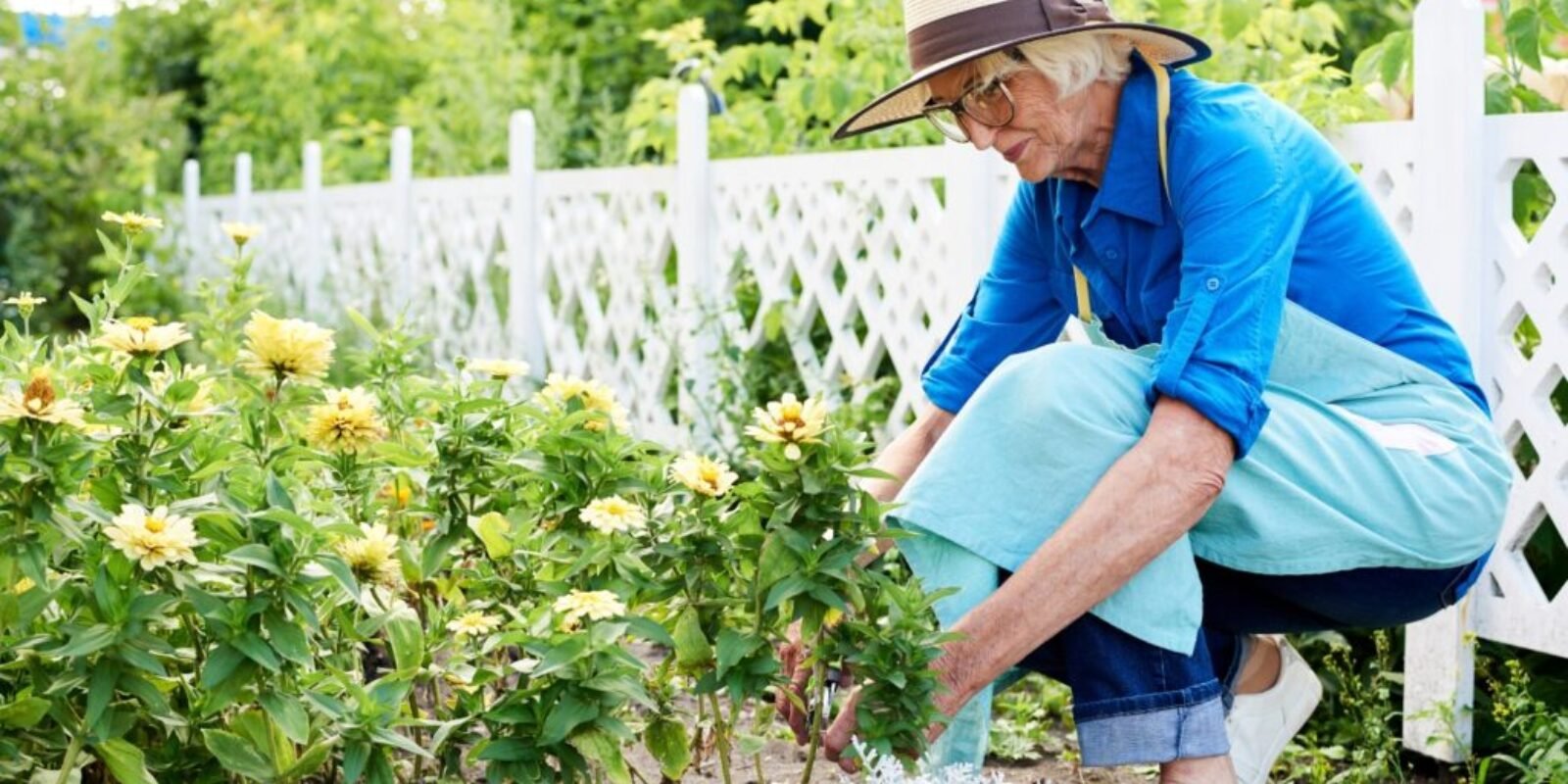Last Updated on June 30, 2025 by Julian Espinosa
Ready to transform your gardening experience into something truly special? Whether you’re a seasoned green thumb or just discovering the joy of nurturing plants, creating the perfect garden sanctuary doesn’t have to be a challenge—it can be your greatest adventure yet.
Gardening offers incredible benefits for mature adults: from boosting mood and reducing stress to providing gentle exercise and connecting you with nature. But here’s the secret—the right tools and techniques can make all the difference between struggling in your garden and absolutely thriving in it.
In this comprehensive guide, you’ll discover the essential items that will revolutionize your gardening experience. We’re talking about ergonomic tools that reduce strain on your joints, innovative raised bed solutions that bring the garden to you, and smart watering systems that practically run themselves. You’ll also learn about low-maintenance plants that deliver maximum beauty with minimal effort, plus safety features that ensure you can garden with complete confidence.
From comfortable seating options that let you pause and enjoy your handiwork to adaptive techniques like vertical gardening, every recommendation is carefully chosen to enhance your gardening journey. We’ve even included protective wear suggestions and accessibility improvements that ensure your garden remains a source of joy for years to come.
Whether you’re looking to start fresh or upgrade your existing garden, this checklist will help you create a space that works beautifully with your lifestyle. Let’s dive into the world of smart, senior-friendly gardening solutions that prove the best gardening years are still ahead of you.
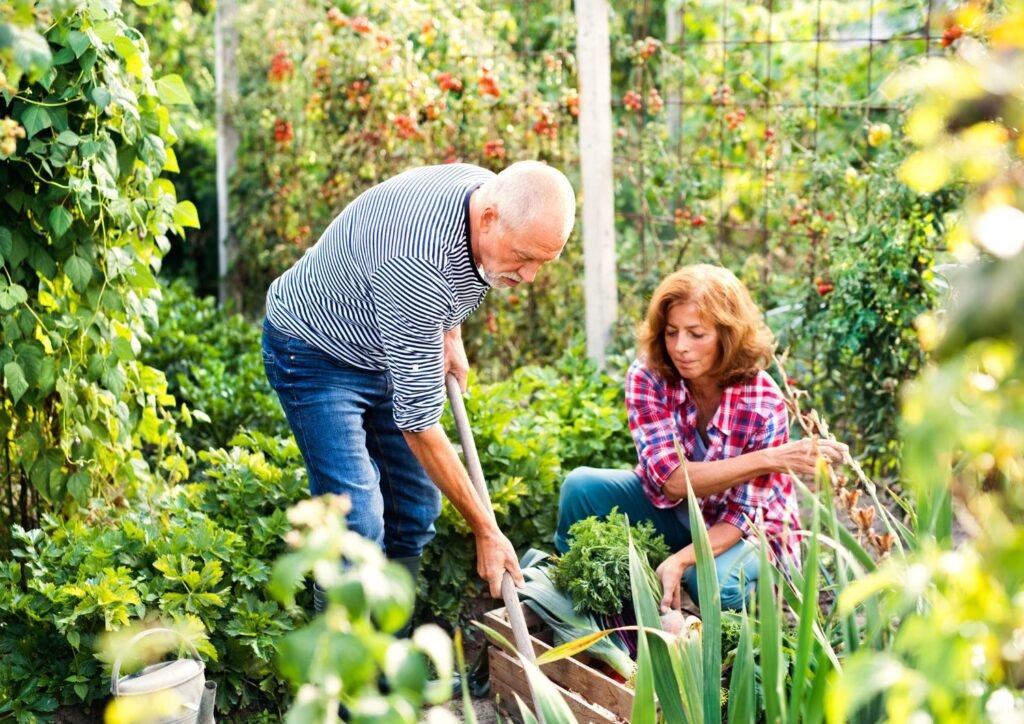
Prefer to listen rather than read?
10 Senior Garden Essentials: Create Your Planting Checklist
Transform your garden with these must-have items tailored for seniors who adore gardening. Whether you’re a seasoned pro or just dipping your toes into the world of gardening, our curated selection promises to elevate your planting game. Count on us to curate your ultimate senior garden essentials checklist, ensuring a flourishing garden experience every step of the way!The foundation of comfortable gardening starts with tools designed with your wellbeing in mind. Traditional gardening tools often require repetitive motions that can exacerbate joint pain, while ergonomic designs align with the body’s natural position, meaning less bending and strain, which is ideal for seniors managing arthritis or muscle issues.
Transform your garden with these must-have items tailored for seniors who adore gardening. Whether you’re a seasoned pro or just dipping your toes into the world of gardening, our curated selection promises to elevate your planting game. Count on us to curate your ultimate senior garden essentials checklist, ensuring a flourishing garden experience every step of the way!
What Makes Tools Truly Ergonomic?
Look for these game-changing features:
Padded, Non-Slip Handles: These provide a cushioned grip that reduces pressure on hands and wrists while preventing blisters and calluses. Tools with padded or non-slip handles ensure a steady hold, accommodating reduced hand strength.
Lightweight Construction: Heavy tools lead to fatigue quickly. Lightweight alternatives allow for easier maneuvering and reduce the effort needed for each task, making gardening sessions more enjoyable and sustainable.
Extended Handle Length: Long-handled tools help prevent pain and fatigue by limiting stress on the back, knees, and hips, often affected by arthritis. These tools let you reach deeper into beds without excessive bending or stretching.
Ratchet Mechanisms: Ratchet pruners and loppers require less force to use compared to traditional tools, making cutting tasks significantly easier on your hands and wrists.
Ergonomic Garden Tools
To begin your senior garden, ensure you have the necessary tools and equipment. Here are some essential tools for senior gardeners:
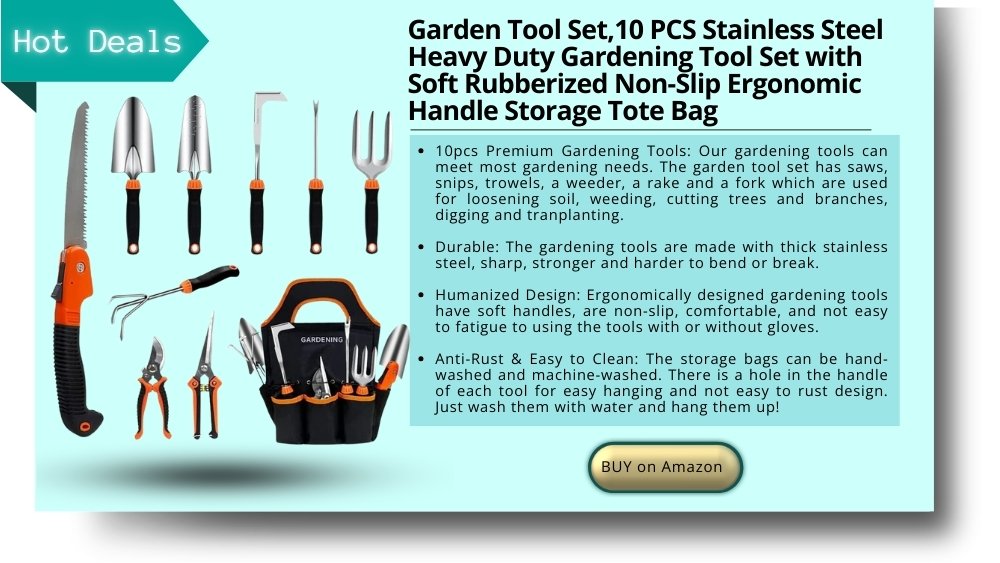
In gardening, the right tools are crucial. Ergonomic garden tools with padded handles can improve the gardening experience significantly. Choose lightweight options for better results.
These tools are specifically designed to reduce strain on joints and muscles, making gardening a more comfortable activity. The padded handles of ergonomic garden tools provide a cushioned grip that helps to alleviate pressure on the hands and wrists.
This is particularly beneficial for individuals who suffer from arthritis or other conditions that affect their hand strength. The padding not only provides comfort but also helps prevent blisters and calluses that can occur from prolonged use of tools with hard handles.
Another advantage of ergonomic garden tools is their lightweight construction. Using heavy tools for an extended period can lead to fatigue and strain on the body. However, lightweight tools allow for easier maneuverability and reduce the amount of effort required to complete gardening tasks. This can be especially beneficial for individuals with limited strength or mobility.
Ergonomic garden tools are lightweight and typically equipped with elongated handles to minimize bending and enhance reach, ultimately eliminating the need for frequent stooping or kneeling during gardening tasks.
A Kneeling Pad: A Must-Have for Senior Gardeners
Picture this: you’re ready to tend to your favorite flower bed, but your knees aren’t quite as cooperative as they used to be. This is where the right support makes all the difference.
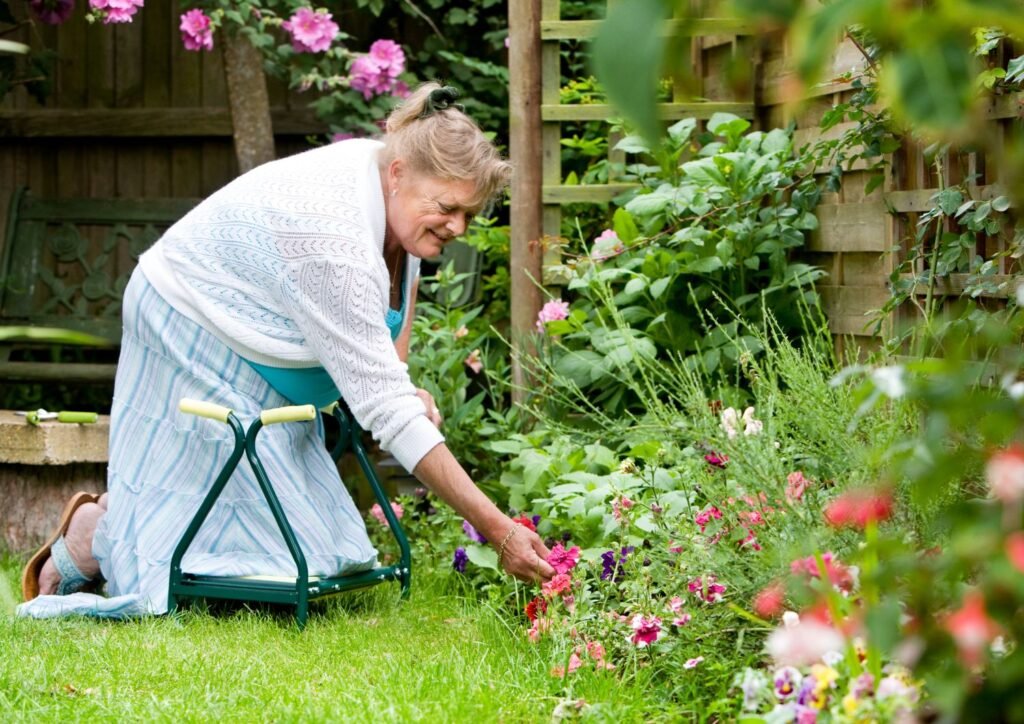
Strategic Seating Solutions
Don’t underestimate the value of well-placed seating throughout your garden. Benches and stools serve multiple purposes:
- Provide rest spots during longer gardening sessions
- Offer perfect vantage points to admire your handiwork
- Create comfortable workstations for tasks like potting or seed starting
- Allow you to pace your activities naturally
Garden Cart: Your Reliable Buddy
A quality garden cart transforms how you approach every gardening task. Instead of making multiple trips carrying heavy bags of soil, delicate plants, and various tools, a sturdy cart with reliable wheels becomes your gardening companion.
Choose a cart with:
- Removable sides for versatility in hauling different materials
- Large, stable wheels that roll smoothly over uneven terrain
- Adequate capacity for your typical gardening supplies
- A comfortable handle height for easy maneuvering
Raised Garden Beds
Raised garden beds can be a lifesaver for adaptive gardeners, as they eliminate the need to bend over or kneel. The ideal height for seniors is typically between 24 to 32 inches.
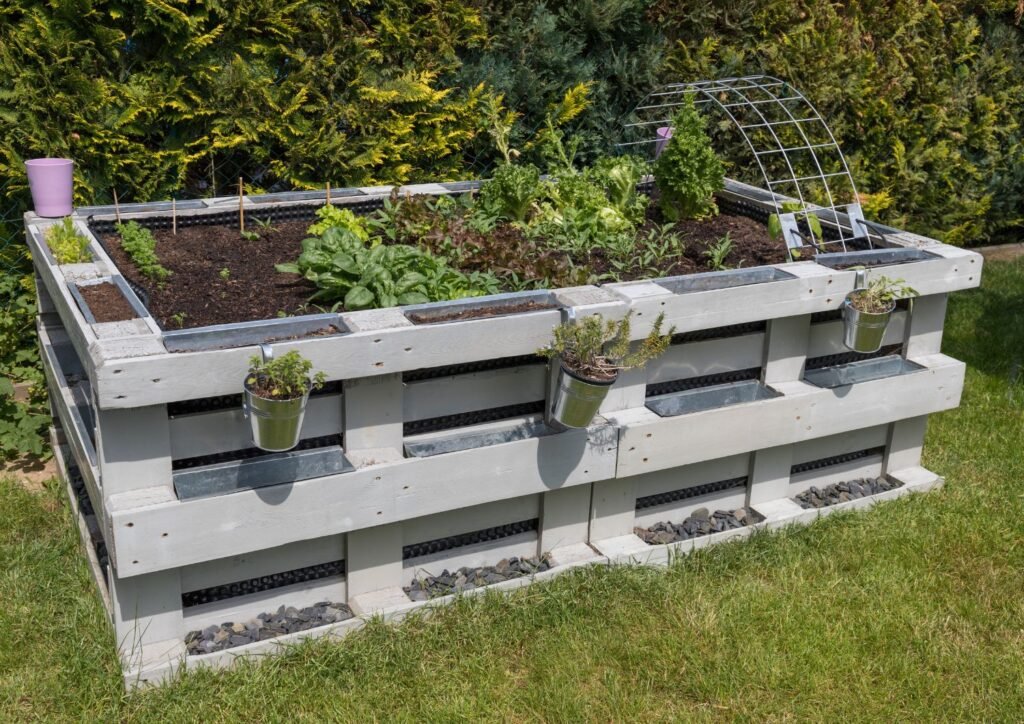
Why Raised Beds Are Revolutionary
The benefits extend far beyond convenience:
- Reduced Physical Strain: Raised beds can make gardening wheelchair-accessible, as all beds can be made to a custom height. As long as the beds are not too wide, a person in a wheelchair will be able to tend to their plants with ease.
- Better Soil Control: You control the soil quality completely, ensuring optimal growing conditions without dealing with poor native soil.
- Improved Drainage: Elevated beds drain more effectively, preventing root rot and other moisture-related plant problems.
- Extended Growing Season: Soil in raised beds warms up faster in spring, giving you a head start on the growing season.
Material Options
- Wood: Cedar and redwood offer natural resistance to decay while providing a classic, warm appearance that complements most garden styles.
- Metal: Galvanized steel and aluminum beds offer exceptional durability and a sleek, modern look that works well in contemporary garden designs.
- Composite Materials: These combine the appearance of wood with enhanced weather resistance and minimal maintenance requirements.
Comfortable Seating Options
When it comes to creating a welcoming nad efficient garden space, choosing the right seating options is a senior garden essential. These choices not only provide comfort but also cater to the need for adequate support and relaxation during gardening activities.
Garden kneelers and seats are the first senior garden essentials that come to mind. They are designed with the gardener’s comfort in mind, offering a cushioned surface for kneeling and a sturdy structure for sitting. These versatile tools protect your knees from strain while weeding or planting and provide much-needed support for tasks that require a closer look.
Another senior garden essential is benches and stools. These items serve a dual purpose: They provide a comfortable spot to take a break and admire your garden’s beauty. Whether it’s a quick rest or a leisurely pause, benches, and stools offer a perfect vantage point to soak in the view.
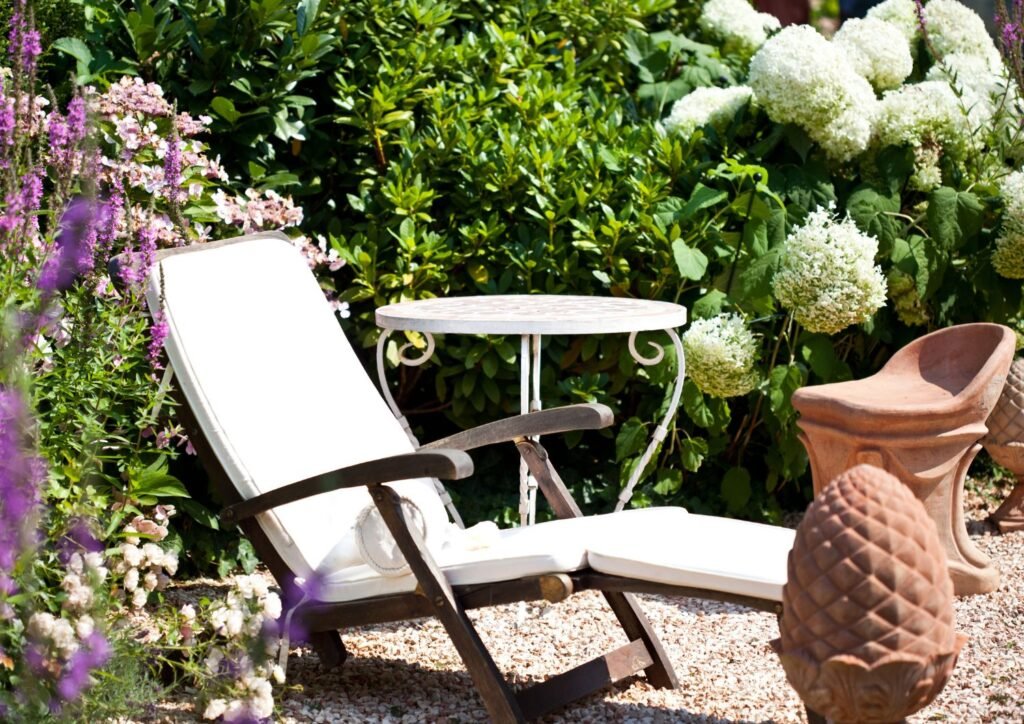
When it comes to gardening expertise and experience, incorporating garden kneelers and seats, as well as benches and stools, is a senior garden essential. These choices enhance the overall gardening experience, ensuring both comfort and efficiency while tending to your beloved plants.
Smart Watering Solutions: Work Smarter, Not Harder
Efficient watering systems save time, conserve water, and ensure your plants receive consistent moisture—the key to healthy, thriving gardens.
Drip Irrigation: Set It and Forget It
Drip irrigation systems represent the pinnacle of gardening efficiency. These systems deliver water directly to plant roots through a network of tubes and emitters, providing several advantages:
- Consistent moisture levels that plants love
- Significant water conservation compared to traditional sprinklers
- Reduced weed growth since water goes only where you want it
- Less disease pressure because foliage stays dry
- Freedom from daily watering chores
Lightweight, Expandable Hoses
Traditional hoses can be cumbersome and difficult to maneuver. Modern expandable hoses solve this problem by:
- Reducing kinking and tangling issues
- Expanding to full length only when water flows through them
- Contracting to a fraction of their size for easy storage
- Weighing significantly less than conventional hoses
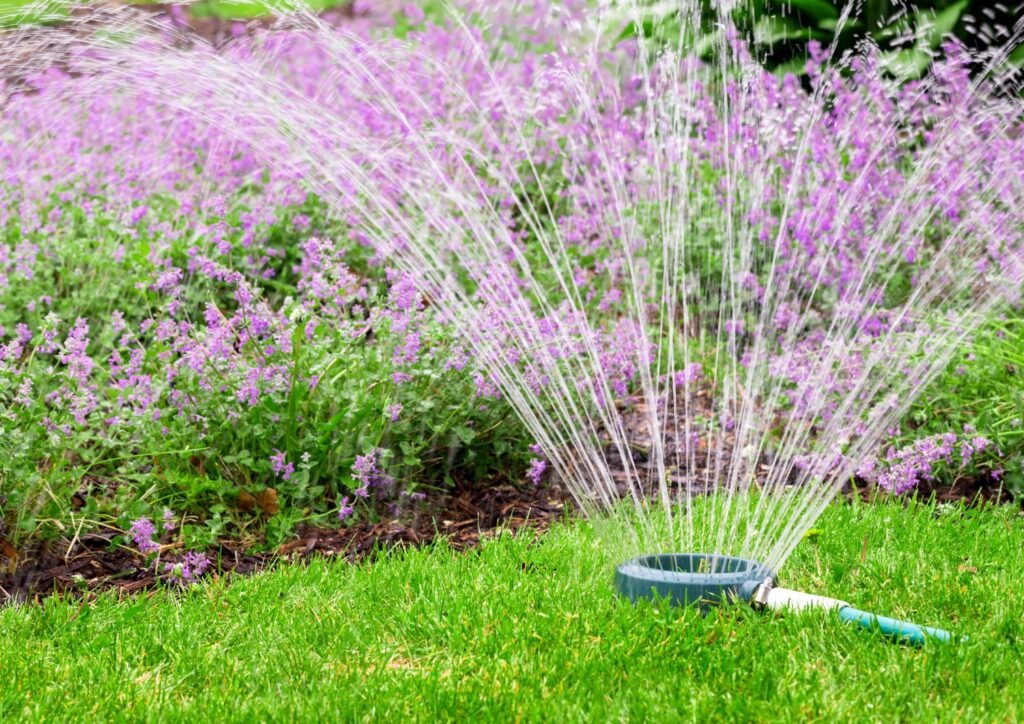
Plants with Lesser Maintenance
Smart plant selection is crucial for creating a garden that brings joy without overwhelming maintenance requirements.
Perennial Plants
Perennials are the backbone of low-maintenance gardens. These plants return year after year, often becoming more beautiful and robust over time. Consider these reliable performers:
- For Sun: Coneflowers, black-eyed Susans, ornamental grasses, sedums, and lavender
- For Shade: Hostas, astilbe, coral bells, ferns, and hellebores
- For Structure: Ornamental grasses, evergreen shrubs, and small flowering trees
Drought-Resistant Varieties
Research shows that gardening relieves stress, increases serotonin levels, boosts the immune system, is good exercise, and may lower the risk of dementia. Choosing plants that thrive with minimal water ensures you can enjoy these benefits without the stress of constant watering.
Excellent drought-tolerant options include:
- Prairie grasses for movement and seasonal interest
- Native wildflowers suited to your region
- Mediterranean herbs like rosemary, thyme, and oregano
- Succulents and cacti for dramatic texture
Protective Garden Wear
When it comes to gardening, especially for our senior garden enthusiasts, the word senior garden essential truly comes to life in the form of protective garden wear. These vital items not only enhance your gardening experience but also prioritize your safety and well-being.
Sun Hats and UV Protection
As we mature, our skin becomes more sensitive to UV damage, making proper sun protection crucial for outdoor activities. Quality sun protection includes:
- Wide-Brimmed Hats: Look for hats with at least 4-inch brims that shade your face, neck, and ears. Materials should be tightly woven and offer UPF (Ultraviolet Protection Factor) ratings when possible.
- UV-Protective Clothing: Modern sun-protective garments combine lightweight, breathable fabrics with excellent UV blocking. Long-sleeved shirts and pants in light colors help reflect heat while protecting skin.
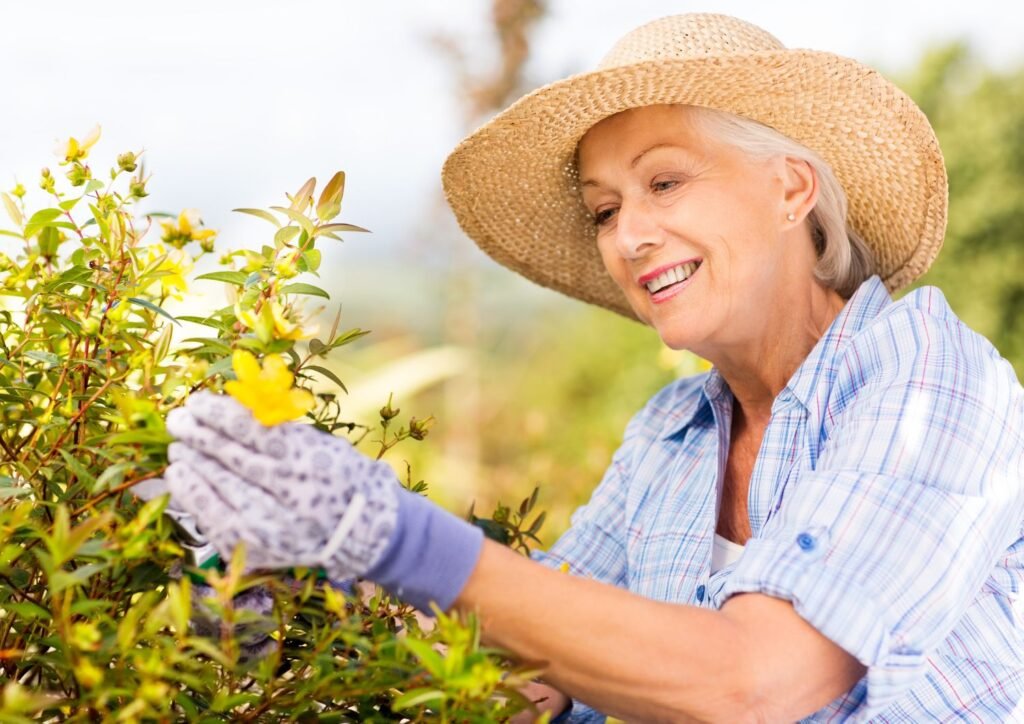
Gardening Footwear
Garden-appropriate footwear should provide:
- Comfortable cushioning for extended wear
- Excellent traction on various surfaces
- Ankle support for uneven terrain
- Toe protection from tools and obstacles
- Easy-to-clean materials that handle mud and moisture
Gardening Gloves
Quality gardening gloves protect against thorns, splinters, and chemicals while maintaining dexterity for detailed tasks. Look for:
- Easy-to-wash materials for hygiene
- Breathable materials that prevent overheating
- Reinforced fingertips and palms for durability
- Snug fit that doesn’t compromise hand movement
Adaptive Garden Techniques
Embracing adaptive garden techniques is key to creating a flourishing garden, especially for senior gardeners. These methods are designed to enhance productivity and ease of tending to the garden.
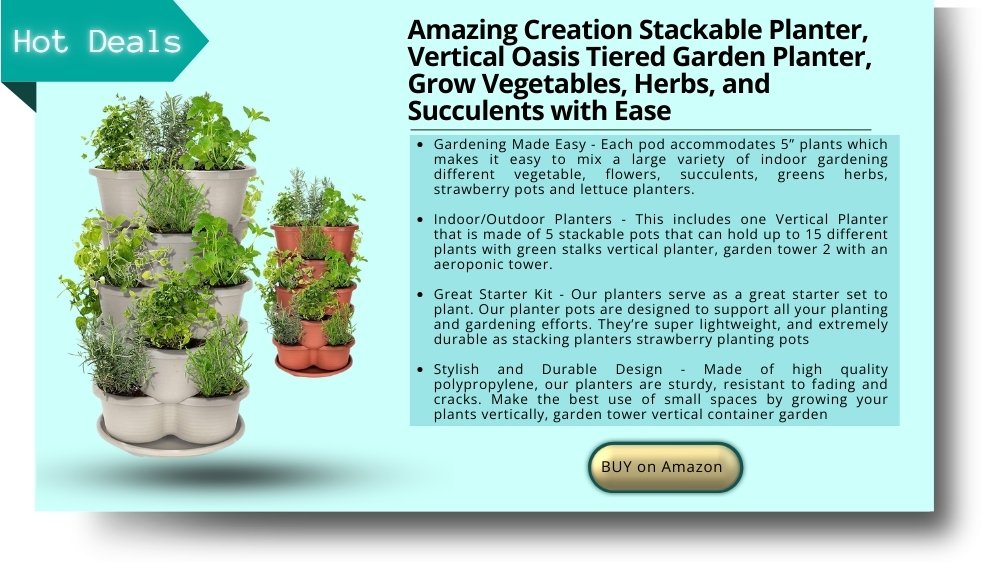
Vertical Gardening: Maximize Space, Minimize Effort
Vertical gardening transforms unused wall space into productive growing areas while reducing the need for bending and ground-level maintenance. Options include:
- Trellises and Wall Systems: Perfect for climbing vegetables like beans and peas, or flowering vines that add vertical interest.
- Hanging Baskets: Ideal for trailing plants, herbs, and flowers at comfortable eye level.
- Tower Gardens: Stackable systems that create impressive displays while keeping plants within easy reach.
Container Gardening: Flexibility at Its Finest
Container gardening offers unmatched versatility:
- Move plants to follow sunlight throughout the season
- Bring tender plants indoors during harsh weather
- Control soil conditions perfectly for each plant’s needs
- Create stunning arrangements that serve as garden focal points
- Eliminate weeding in planting areas
Garden Maintenance Aids
When it comes to keeping your garden in pristine condition, senior garden essential tools play a crucial role in ensuring teh expertise and experience needed for effective garden maintenance. These tools not only make the task more manageable but also emphasize the authoritativeness and trustworthiness of your gardening efforts.
Pruning Assistance Tools
Extended-reach pruners eliminate the need for ladders while allowing precise cuts on higher branches. Joint-friendly designs, such as ratchet pruners and loppers, require less force to use and reduce fatigue during pruning sessions.
Efficient Weed Management
Modern weed management focuses on prevention and smart tools:
- Weed Barriers: Landscape fabric and organic mulches prevent weeds from establishing while conserving soil moisture.
- Stand-Up Weeders: These tools allow you to remove weeds while standing upright, eliminating the need for kneeling or bending.
- Mulching Strategies: Thick layers of organic mulch suppress weeds naturally while improving soil as they decompose.
Garden Safety and Accessibility
Creating a safe and enjoyable garden for seniors involves paying attention to a few key aspects. Senior garden essentials can greatly enhance their outdoor experience while minimizing potential hazards.
Non-Slip Paths
Safe garden navigation starts with proper pathways. Non-slip paths reduce the risk of falls by providing better traction underfoot, making it easier to navigate the garden safely, even in wet conditions.
Effective pathway materials include:
- Proper grading to prevent water accumulation
- Textured pavers that provide grip without being rough on feet
- Decomposed granite that compacts well and drains effectively
- Rubber matting in high-traffic areas for maximum slip resistance
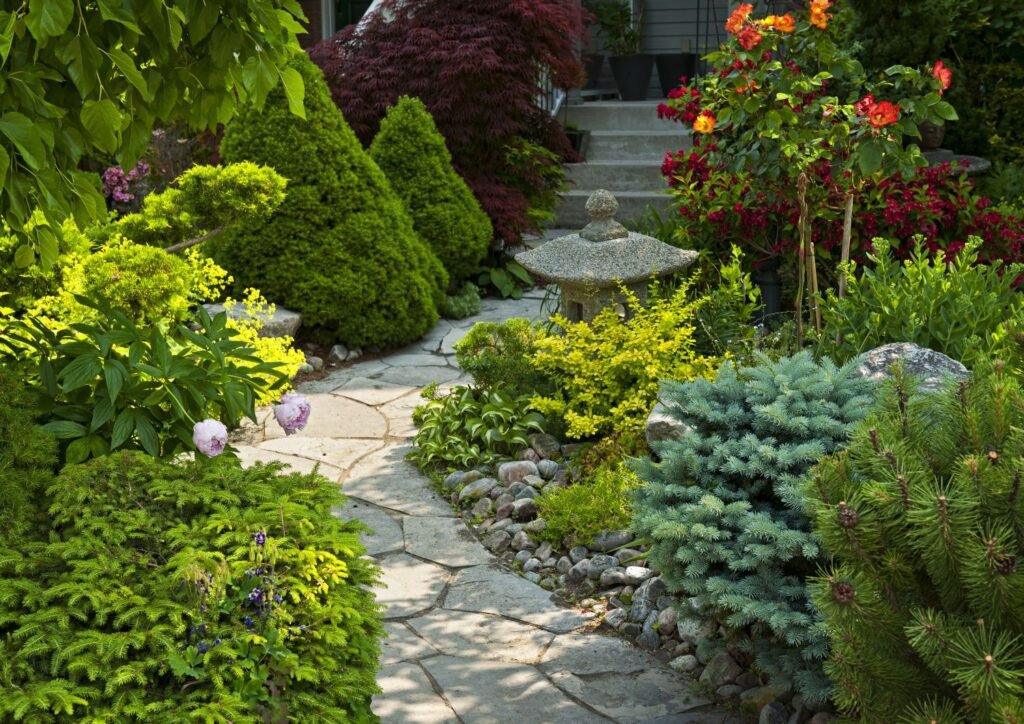
Garden Lighting
Strategic lighting extends your garden enjoyment into evening hours while enhancing safety:
- Solar Path Lights: Environmentally friendly options that charge during the day and automatically illuminate pathways at night.
- Motion-Activated Lights: Provide bright illumination when needed while conserving energy and deterring unwanted visitors.
- Low-Voltage Systems: Professional-grade lighting that highlights garden features while maintaining safety along pathways and seating areas.
Creating Your Personal Garden Sanctuary
Your garden should reflect your personality while accommodating your physical needs and lifestyle preferences. Consider these personalization strategies:
Themed Garden Areas
Create distinct spaces within your garden:
- Herb gardens near the kitchen for easy access during cooking
- Meditation spaces with comfortable seating and fragrant plants
- Cutting gardens that provide flowers for indoor arrangements
- Vegetable areas that supply fresh produce for your table
Seasonal Interest Planning
Design your garden to provide beauty throughout the year:
- Spring bulbs for early season color
- Summer perennials for sustained blooms
- Fall foliage plants for autumn interest
- Evergreen structure for winter appeal
Wildlife Integration
Attract beneficial wildlife that helps your garden thrive:
- Native plants that support local ecosystems
- Water features that provide drinking spots for birds
- Pollinator-friendly flowers that ensure good fruit and vegetable production
- Nesting boxes and habitat features that encourage beneficial insects
The journey of gardening evolves beautifully with each season of life. By choosing the right tools, techniques, and approaches, you can create a garden space that brings endless joy while working in harmony with your body and lifestyle. Remember, the most successful gardens are those that reflect the gardener’s personality while providing sustainable beauty and satisfaction.
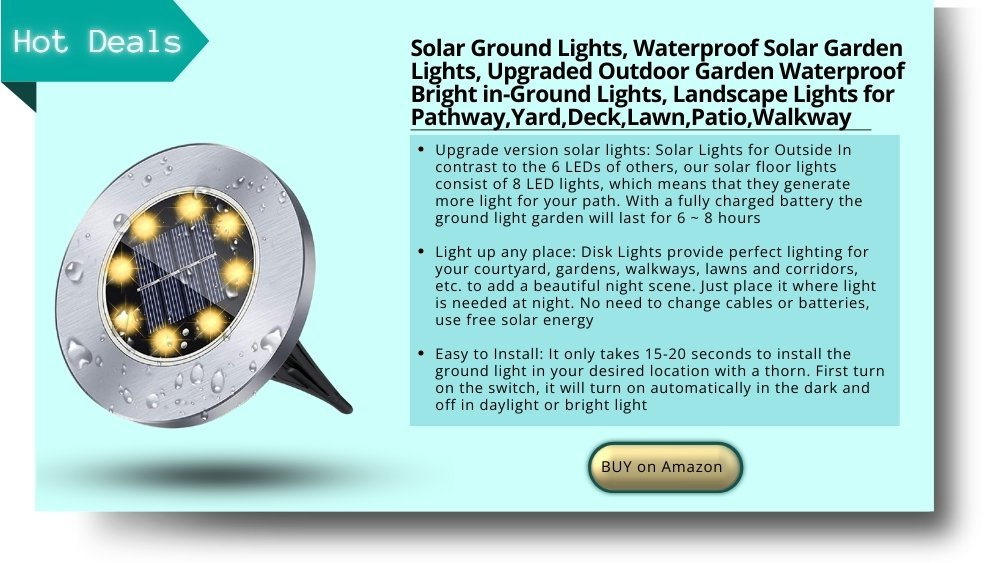
The Takeaway
Your garden is more than just a collection of plants—it’s your personal retreat, your creative expression, and your connection to the natural world. With these essential tools and techniques, you’re well-equipped to create a garden that will flourish alongside you for many seasons to come.
Do you have specific areas of your garden that you’d love to make more accessible? What gardening challenges would you most like to overcome? Share your thoughts in the comments below—we’d love to hear about your gardening experiences and help you create the garden of your dreams!
FAQ: Senior Garden Essentials
- What’s the most important factor when choosing ergonomic garden tools?
- The most crucial factor is finding tools that fit your specific physical needs. Look for lightweight options with padded, non-slip handles and consider your grip strength when selecting tools. Ratchet mechanisms can significantly reduce the force needed for cutting tasks, while extended handles minimize bending and reaching.
- How high should raised garden beds be for comfortable gardening?
- The ideal height for raised garden beds is typically between 24-32 inches, which allows most people to garden comfortably while standing. For wheelchair accessibility, beds should be 30-32 inches high with adequate clearance underneath. The width should not exceed 4 feet so you can easily reach the center from either side.
- Are drip irrigation systems difficult to install and maintain?
- Modern drip irrigation systems are designed for easy installation and minimal maintenance. Most systems use simple push-fit connectors that don’t require special tools. Maintenance involves occasional cleaning of emitters and checking for clogs. Many systems include timers that automate watering schedules, making them incredibly user-friendly.
- What are the best low-maintenance plants for beginning gardeners?
- Start with native perennials adapted to your climate zone, as they require minimal care once established. Excellent beginner-friendly options include coneflowers, black-eyed Susans, ornamental grasses, sedums, and regional native wildflowers. These plants are drought-tolerant, disease-resistant, and provide years of beauty with minimal intervention.
- How can I make my existing garden paths safer without major renovation?
- Add non-slip surfaces using removable rubber mats or textured strips in problem areas. Improve lighting with solar stake lights along pathway edges. Keep paths clear of debris and trim overhanging branches. Consider adding handrails along sloped sections and ensure proper drainage to prevent puddles and ice formation.
- What’s the best way to prevent garden-related injuries?
- Focus on proper pacing, ergonomic tools, and listening to your body. Take frequent breaks, especially during longer gardening sessions. Use tools designed to reduce strain, wear appropriate protective gear, and avoid working in extreme weather conditions. If something causes pain, stop and reassess your approach rather than pushing through discomfort.
- Can container gardening provide enough space for vegetables?
- Absolutely! Many vegetables thrive in containers and can be very productive in smaller spaces. Use large containers (at least 5-gallon capacity) for tomatoes, peppers, and eggplants. Herbs, lettuce, and radishes do well in smaller pots. Choose compact or dwarf varieties specifically bred for container growing, and ensure adequate drainage and consistent watering.
- How do I choose between wood, metal, and composite materials for raised beds?
- Consider your budget, climate, and aesthetic preferences. Cedar and redwood are naturally rot-resistant but require periodic maintenance. Galvanized steel lasts decades with minimal upkeep but can get hot in direct sun. Composite materials offer the look of wood with enhanced durability but typically cost more initially. All options can provide excellent growing conditions when properly constructed.
REFERENCES
- In the Garden Sue. (2024). “Best Garden Tool Designs for Arthritis or the Elderly.” Retrieved from https://inthegardensue.com/blog/the-best-garden-tools-designs-for-arthritis-or-the-elderly
- INSPIRE Occupational Therapy. (2023). “Ergonomic Yard Tools: A Senior’s Best Friend for Garden Work.” Retrieved from https://iptw.com/occupational-therapy-ergonomic-yard-tools-for-seniors/
- QuickScream. (2024). “Gardening Tools for People With Arthritis.” Retrieved from https://www.quickscream.com/gardening-tools-for-people-with-arthritis/
- Durable GreenBed. (2024). “Accessible Raised Garden Beds – Adaptive Gardening.” Retrieved from https://durablegreenbed.com/adaptive-gardening-in-raised-beds/
- Vegega. (2025). “Benefits of Raised Garden Beds for Older Gardeners.” Retrieved from https://www.vegega.com/blogs/our-garden-bed/benefits-of-raised-garden-beds-for-older-gardeners
- AgeSpace. (2025). “Raised Garden Beds: What raised beds are and how to set them up.” Retrieved from https://www.agespace.org/real-life/raised-beds
- Durable GreenBed. (2022). “Raised Garden Beds for Seniors – Accessible Solutions.” Retrieved from https://durablegreenbed.com/raised-garden-beds-for-senior-residence/
- Arthritis.org. (2021). “Make Gardening Easier With These Helpful Garden Tools.” Retrieved from https://www.arthritis.org/health-wellness/healthy-living/daily-living/life-hacks-tips/helpful-garden-tools
- Senior Safety Advice. (2025). “The Best Gardening Tools For Seniors (2024).” Retrieved from https://seniorsafetyadvice.com/gardening-tools-for-seniors/
